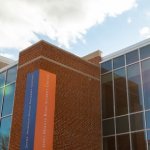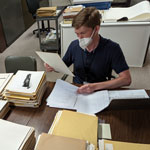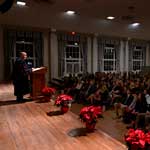

We take for granted the ability to pick up our phones and send a tweet or text. If you’ve ever been at a concert or event without cellular service, you’ve likely felt the frustration that accompanies not being able to send a picture to your family or friends.
Now think of an event like The Republican and Democratic presidential conventions. They are two of the largest events in America, hosting 50,000 visitors each—including 15,000 members of the media—during a one-week period. To keep that many people connected and online is no small task. At the Republican convention, 2.8 terabytes of traffic moved through the mobile network of the Quicken Loans arena—the equivalent of roughly 8 million selfies, according to stats provided by AT&T.
Another point of comparison: “It’s like 100,000 viewers watching the Game of Thrones per hour,” said Jack Duffy ’79, the vice president of program management for the 2016 conventions at AT&T. “The technological consumption that took place in the Wells Fargo Center during the Democratic National Convention set the record for usage.”
To put it simply, where there are a lot of people, there are also significant technological needs.
This was the first time AT&T was an official provider for the presidential conventions since its merger with DirecTV in July 2015. Duffy took over program management of the conventions in April of last year but has worked for AT&T for 37 years in a variety of roles, from serving as vice president of marketing to working in customer service operations.
In this new role, Duffy leads a team of eight senior leadership members, and there are about 600 people working under the program management umbrella. They are responsible for managing the wireline and mobility networks, implementing both temporary and permanent network enhancements, communicating and working with the Department of Homeland Security and Secret Service, and everything in between. The end goal: making communications and connectivity seamless.

After months and months of preparation, the final stretch of work took place in the span of just a few weeks. The Cleveland Cavaliers made the playoffs (and would go on to win the NBA Title), leaving the Quicken Loans arena off limits until late June, with the Republican convention due to kick off July 18.
“Ultimately, we had 25 days to do 15,000 hours of labor and to lay 17 miles of fiber and copper build,” said Duffy. “I stood on the floor the day the Cavaliers played Game 6. I was able to see what the arena looked like for a world class sporting event, and then 30 days later the floor I was standing on was a convention. The process is incredible.”
 Among the more stressful moments at the Republican National Convention was when the red, white, and blue lights behind Newt Gingrich went dark during his speech. Duffy, who had been standing below the box where Republican presidential nominee Donald Trump’s family was standing, gracefully made his way around the press cameras, walked behind the stage and ran down four flights of stairs in search of the problem. After receiving questions from the CEO of the convention and dozens of frantic phone calls, they determined it wasn’t AT&T’s fault, but the result of a hardware issue. Still, “I describe those 20 minutes as the most stressful of my 37-year career,” said Duffy.
Among the more stressful moments at the Republican National Convention was when the red, white, and blue lights behind Newt Gingrich went dark during his speech. Duffy, who had been standing below the box where Republican presidential nominee Donald Trump’s family was standing, gracefully made his way around the press cameras, walked behind the stage and ran down four flights of stairs in search of the problem. After receiving questions from the CEO of the convention and dozens of frantic phone calls, they determined it wasn’t AT&T’s fault, but the result of a hardware issue. Still, “I describe those 20 minutes as the most stressful of my 37-year career,” said Duffy.
Preparing for Philadelphia was easier than Cleveland had been. AT&T had already done significant work throughout the city in preparation for Pope Francis’s visit in 2015, and a Justin Bieber concert held in May a few months before the convention helped them work out the rest of the kinks.
 “Thank you, Justin Bieber,” Duffy joked.
“Thank you, Justin Bieber,” Duffy joked.
Looking back on the conventions, Duffy is able to look past the stress and lack of sleep and appreciate the experience.
“How I describe the conventions is it’s kind of like college,” said Duffy. “As you get further out, you remember the friendships you made, you remember the fun, but you don’t remember all the stress.”
Post-convention, both Cleveland and Philadelphia benefit from having a stronger technological infrastructure in place. And the memories are priceless. Talking with reporters on the floor of the conventions, working with high-level elected officials— you name it, Duffy did it.
 “The last night in Philadelphia, I sat between the mayor of San Francisco and Lyndon Baines Johnson’s two daughters,” said Duffy. “It’s those kinds of interactions. I met Charlie Rose, Lester Holt, Chuck Todd, Norah O’Donnell, Andrea Mitchell—I talked to Bob Schieffer and Tom Brokaw. Seeing the media doing their work and interacting, those things are priceless.”
“The last night in Philadelphia, I sat between the mayor of San Francisco and Lyndon Baines Johnson’s two daughters,” said Duffy. “It’s those kinds of interactions. I met Charlie Rose, Lester Holt, Chuck Todd, Norah O’Donnell, Andrea Mitchell—I talked to Bob Schieffer and Tom Brokaw. Seeing the media doing their work and interacting, those things are priceless.”
Read about Duffy’s work serving as a career connector for Gettysburg students.


